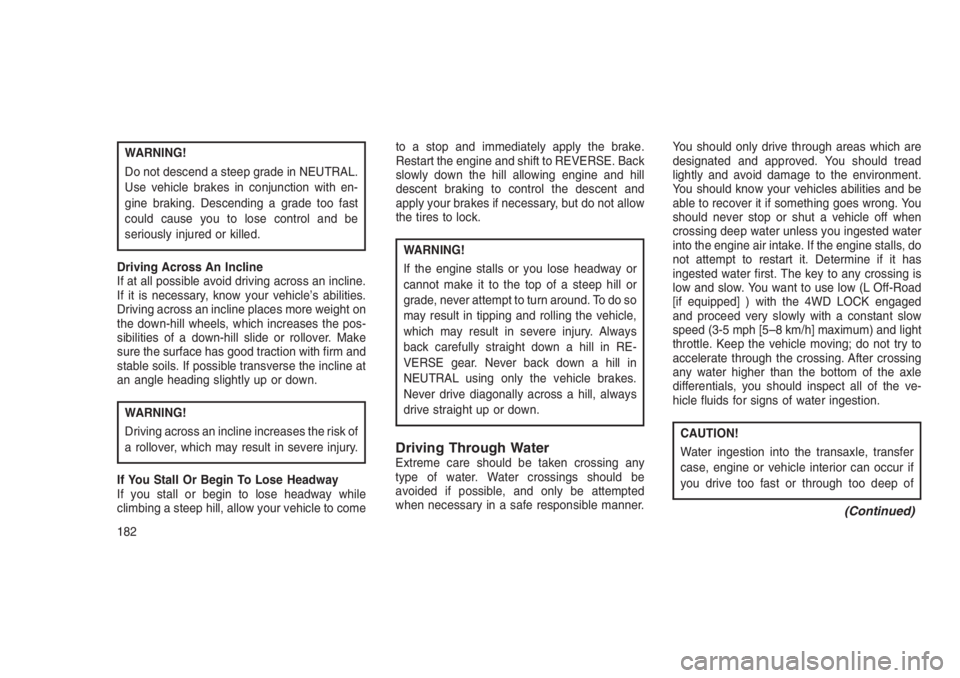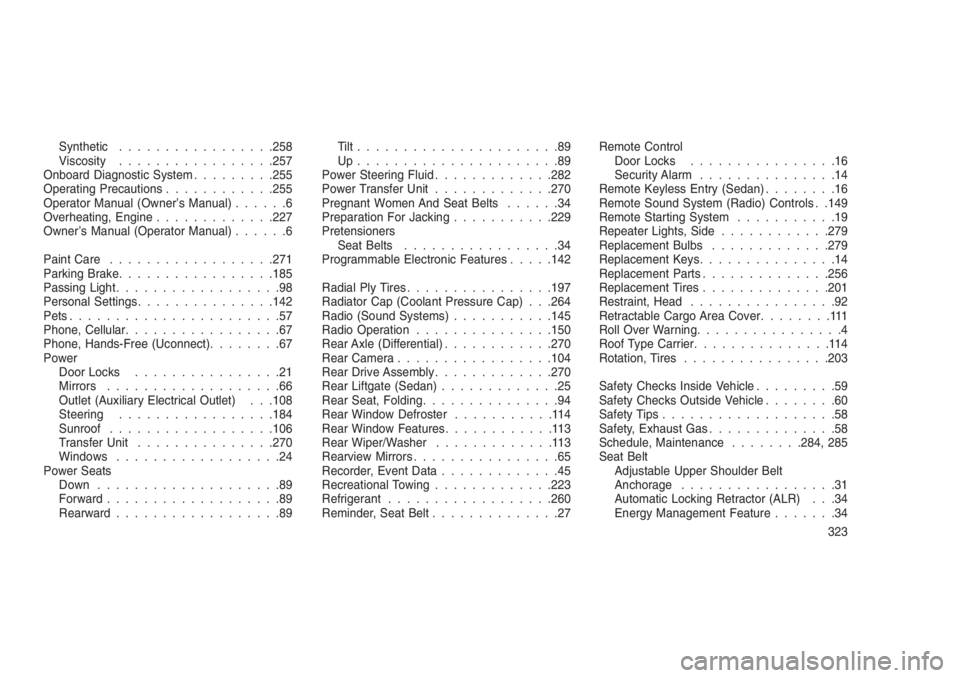differential JEEP PATRIOT 2020 Owner handbook (in English)
[x] Cancel search | Manufacturer: JEEP, Model Year: 2020, Model line: PATRIOT, Model: JEEP PATRIOT 2020Pages: 332, PDF Size: 1.99 MB
Page 186 of 332

WARNING!
Do not descend a steep grade in NEUTRAL.
Use vehicle brakes in conjunction with en-
gine braking. Descending a grade too fast
could cause you to lose control and be
seriously injured or killed.
Driving Across An Incline
If at all possible avoid driving across an incline.
If it is necessary, know your vehicle’s abilities.
Driving across an incline places more weight on
the down-hill wheels, which increases the pos-
sibilities of a down-hill slide or rollover. Make
sure the surface has good traction with firm and
stable soils. If possible transverse the incline at
an angle heading slightly up or down.
WARNING!
Driving across an incline increases the risk of
a rollover, which may result in severe injury.
If You Stall Or Begin To Lose Headway
If you stall or begin to lose headway while
climbing a steep hill, allow your vehicle to cometo a stop and immediately apply the brake.
Restart the engine and shift to REVERSE. Back
slowly down the hill allowing engine and hill
descent braking to control the descent and
apply your brakes if necessary, but do not allow
the tires to lock.
WARNING!
If the engine stalls or you lose headway or
cannot make it to the top of a steep hill or
grade, never attempt to turn around. To do so
may result in tipping and rolling the vehicle,
which may result in severe injury. Always
back carefully straight down a hill in RE-
VERSE gear. Never back down a hill in
NEUTRAL using only the vehicle brakes.
Never drive diagonally across a hill, always
drive straight up or down.
Driving Through WaterExtreme care should be taken crossing any
type of water. Water crossings should be
avoided if possible, and only be attempted
when necessary in a safe responsible manner.You should only drive through areas which are
designated and approved. You should tread
lightly and avoid damage to the environment.
You should know your vehicles abilities and be
able to recover it if something goes wrong. You
should never stop or shut a vehicle off when
crossing deep water unless you ingested water
into the engine air intake. If the engine stalls, do
not attempt to restart it. Determine if it has
ingested water first. The key to any crossing is
low and slow. You want to use low (L Off-Road
[if equipped] ) with the 4WD LOCK engaged
and proceed very slowly with a constant slow
speed (3-5 mph [5–8 km/h] maximum) and light
throttle. Keep the vehicle moving; do not try to
accelerate through the crossing. After crossing
any water higher than the bottom of the axle
differentials, you should inspect all of the ve-
hicle fluids for signs of water ingestion.
CAUTION!
Water ingestion into the transaxle, transfer
case, engine or vehicle interior can occur if
you drive too fast or through too deep of
(Continued)
182
Page 195 of 332

four times within twenty seconds. The “ESC
Off Indicator Light” should turn on and turn
off two times.
7. Rotate the steering wheel back to center and
then an additional slighty more than one-half
turn to the right.
8. Turn the ignition switch to the OFF position
and then back to the ON position. If the
sequence was completed properly, the “ESC
Off Indicator Light” will blink several times to
confirm HSA is disabled.
9. Repeat these steps if you want to return this
feature to its previous setting.
Traction Control System (TCS)This system monitors the amount of wheel spin
of each of the driven wheels. If wheel spin is
detected, the TCS may apply brake pressure to
the spinning wheel(s) and/or reduce engine
power to provide enhanced acceleration and
stability. A feature of the TCS, Brake Limited
Differential (BLD), functions similar to a limited
slip differential and controls the wheel spin
across a driven axle. If one wheel on a drivenaxle is spinning faster than the other, the sys-
tem will apply the brake of the spinning wheel.
This will allow more engine torque to be applied
to the wheel that is not spinning. BLD may
remain enabled even if TCS and ESC are in a
reduced mode.
Electronic Stability Control (ESC)This system enhances directional control and
stability of the vehicle under various driving
conditions. ESC corrects for over-steering or
under-steering of the vehicle by applying the
brake of the appropriate wheel to assist in
counteracting the over-steering or under-
steering condition. Engine power may also be
reduced to help the vehicle maintain the desired
path. ESC uses sensors in the vehicle to deter-
mine the vehicle path intended by the driver and
compares it to the actual path of the vehicle.
When the actual path does not match the
intended path, ESC applies the brake of the
appropriate wheel to assist in counteracting the
over-steer or under-steer condition
•Oversteer - when the vehicle is turning more
than appropriate for the steering wheel posi-
tion.•Understeer - when the vehicle is turning less
than appropriate for the steering wheel
position.
WARNING!
•The Electronic Stability Control (ESC) can-
not prevent the natural laws of physics
from acting on the vehicle, nor can it
increase the traction afforded by prevailing
road conditions.
•ESC cannot prevent accidents, including
those resulting from excessive speed in
turns, driving on very slippery surfaces, or
hydroplaning. ESC also cannot prevent
collisions resulting from loss of vehicle
control due to inappropriate driver input for
the conditions. Only a safe, attentive, and
skillful driver can prevent collisions.
(Continued)
191
Page 327 of 332

Synthetic.................258
Viscosity.................257
Onboard Diagnostic System.........255
Operating Precautions............255
Operator Manual (Owner’s Manual)......6
Overheating, Engine.............227
Owner’s Manual (Operator Manual)......6
Paint Care..................271
Parking Brake.................185
Passing Light..................98
Personal Settings...............142
Pets.......................57
Phone, Cellular.................67
Phone, Hands-Free (Uconnect)........67
Power
Door Locks................21
Mirrors...................66
Outlet (Auxiliary Electrical Outlet) . . .108
Steering.................184
Sunroof..................106
Transfer Unit...............270
Windows..................24
Power Seats
Down....................89
Forward...................89
Rearward..................89Tilt......................89
Up......................89
Power Steering Fluid.............282
Power Transfer Unit.............270
Pregnant Women And Seat Belts......34
Preparation For Jacking...........229
Pretensioners
Seat Belts.................34
Programmable Electronic Features.....142
Radial Ply Tires................197
Radiator Cap (Coolant Pressure Cap) . . .264
Radio (Sound Systems)...........145
Radio Operation...............150
Rear Axle (Differential)............270
Rear Camera.................104
Rear Drive Assembly.............270
Rear Liftgate (Sedan).............25
Rear Seat, Folding...............94
Rear Window Defroster...........114
Rear Window Features............113
Rear Wiper/Washer.............113
Rearview Mirrors................65
Recorder, Event Data.............45
Recreational Towing.............223
Refrigerant..................260
Reminder, Seat Belt..............27Remote Control
Door Locks................16
Security Alarm...............14
Remote Keyless Entry (Sedan)........16
Remote Sound System (Radio) Controls . .149
Remote Starting System...........19
Repeater Lights, Side............279
Replacement Bulbs.............279
Replacement Keys...............14
Replacement Parts..............256
Replacement Tires..............201
Restraint, Head................92
Retractable Cargo Area Cover........111
Roll Over Warning................4
Roof Type Carrier...............114
Rotation, Tires................203
Safety Checks Inside Vehicle.........59
Safety Checks Outside Vehicle........60
Safety Tips...................58
Safety, Exhaust Gas..............58
Schedule, Maintenance........284, 285
Seat Belt
Adjustable Upper Shoulder Belt
Anchorage.................31
Automatic Locking Retractor (ALR) . . .34
Energy Management Feature.......34
323